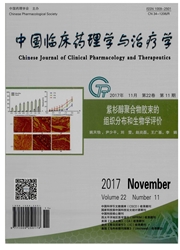

 中文摘要:
中文摘要:
目的:建立丹参酚酸B的反相高效液相色谱分析方法,并对其在大鼠体内的药代动力学行为特性进行全面的分析研究。方法:生物样品采用液-液萃取方法,以Hypersil C18 ODS色谱柱(200mm×4.6mm,5μm),柱温40℃,流动相:乙腈:水=20:80(含o.25mol/L乙酸胺),用磷酸调pH至4.0,流速:1.0mL/min;紫外检测波长:328nm。结果:鼠尾静脉给予丹参酚酸B1.6、3.2、6.4mg/kg后,结果显示鼠a相半衰期为(3.1±0.1)min,8相半衰期为(31.5±3.2)min。大鼠尾静脉给予丹酚酸B后,组织中浓度依次为(高-低):心、肝、肺、小肠、肾脏、脾、胃、卵巢和脑组织。丹参酚酸B在粪便和尿中24h及胆汁中2h的累积排泄百分数分别约为1、43%、0.77%及8.03%。丹参酚酸B人血浆蛋白结合率和大鼠血浆蛋白结合率分别为89.2%±1.8%和92.5%±1.5%。结论:本法准确、稳定、灵敏度高,适合生物样品中丹参酚酸B的分析。丹参酚酸B在大鼠体内消除速度快,血浆蛋白结合率较高,胆汁为其主要排泄途径。
 英文摘要:
英文摘要:
AIM: To establish an HPLC mehod for the analysis of phannacokinetics of salvianolic acid B in rats. METHODS: The biological samples were extracted with acetic ether. The chromatographic conditions were as follows: Hypersil ODS column (200 mm ×4.6 mm, 5μm) was used. The mobile phase was acetonitrile-water (with Ammoniom Acetate 0.25 mol/L) (25 : 75, v/v) at a flow-rate of 1.0 mL/min, and the detection wave length was set at 328 nm. RESULTS: Salvianolic acid B was injected intravenously at doses of 1.6, 3.2, 6.4 mg/kg. The terminal elimination half-life( t1.2 ) of a phase and β phase was (3.1±0.1) rain and (31.5+3.2) rain. The extents of excrement, urine and biliary excretion of salvianolic acid B were 1.43 % ±0.90 %, 0.77 % ± 1.01% and 8.82% ± 4.11%. The tissue concentration of salvianolic acid B was as followed in order: Chcart 〉 Cliver 〉 Clung 〉 Cintestine〉 Ckidney 〉 Cspleen 〉 Cstoolach. The plasma protein binding rate of salvianolic acid B in human plasma and in rat was similar (89.2 % ± 1.8 %, 92.5 % ± 1.5% ). CONCLUSION: The method is accurate, stable and reliable, and can be used for the investigation of salvianolic acid B in phannacokinetics research. Salvianolic acid B eliminates fast and it shows a high plasma protein binding rate, the mainly excretion way of salvianolic acid B is from biliary.
 同期刊论文项目
同期刊论文项目
 同项目期刊论文
同项目期刊论文
 期刊信息
期刊信息
